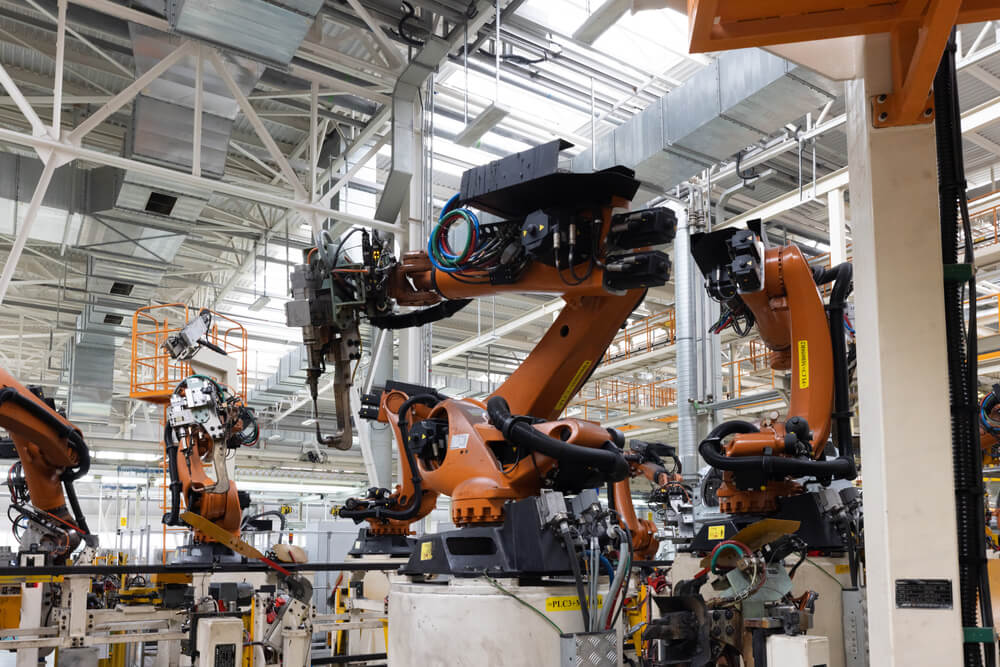Industry 4.0 can be understood as the fourth industrial revolution, heralded in through a convergence of technologies that lean heavily on continuous data gathering and artificial intelligence in a networked environment to present a new form of agile, responsive, and customizable manufacturing. Originally, the term was coined in Germany, where it is spelled as ”Industry 4.0”.
This e-book, written collaboratively by experts in the fields of robotics, manufacturing, IoT, engineering, aims to provide an overview of the technologies that drive the current changes in the way we work and manufacture. It describes how Industry 4.0 came to be and dives into all the components that come together to create this new industrial paradigm.
Historical perspective and future possibilities on industrial revolutions
The beginning of machine-assisted linear production was defined by highly detailed specifications, a single or highly hierarchical system integrator, and the mass production of items. Changes to the product or system required a complete tear-down and rebuild. This type of system was only economically viable to large manufacturers, in big plants producing huge volumes. In contrast, Industry 4.0 applies to facilities of all sizes. An Industry 4.0 manufacturing facility collects data at all stages of its production process allowing it to make regular, intelligently informed decisions about productivity, safety, and efficiency. The exemplar of Industry 4.0 heralds in a new understanding of manufacturing that is agile, lean, highly customizable, and viable at all scales.
Artificial intelligence and data-driven insights in Industry 4.0
AI has been of interest to the manufacturing industry since the 1980s and has been applied across the entire production cycle from the planning and design phase, system and maintenance design, to its latest iterations in collaborative robots. Recent advances in sensors mean that all aspects of the factory can be under real-time continuous monitoring, generating an enormous amount of data. Advanced analytics provide the potential to convert these large datasets into actionable insights in real-time.

Manufacturing facilities have long been deeply embedded with sensors or all kinds, but significant advances in wireless network technologies now facilitate inter-sensor communications which are fundamental to the functioning of industrial IoT. These advances have also reduced the capital costs allowing access for smaller manufacturers.
The availability of relevant data and the systems to analyze it makes automation of some or all of the production process within a manufacturing facility possible. It offers control to operations of all sizes to understand its functions to a granular level without additional management or complex quality control. Companies wishing to meet the aspirations offered by Industry 4.0 will embrace a data-driven approach to both their facilities and approach to the market.
Hardware and human interfaces in the industry 4.0
A fundamental aspect of Industry 4.0 is the evolution and continuous improvement of robotic systems. Even as recently as a decade ago, robotics were accessible to only the largest of factories. Today robotics are being implemented into production facilities of all sizes. The evolution of robotics to more affordable, versatile, and easier to operate machines has also brought the collaborative robot, or ‘cobot,’ to the factory floor. These small, lightweight, and significantly cheaper robots work collaboratively alongside human workers to increase productivity, create safer work environments, and augment human quality control abilities.
Initially, these cobots acted as guides and heavy lifters, assisting humans with repetitive heavy labor, but have since evolved into active machines that can employ their ‘senses’ to work intuitively with humans on complex assembly tasks. Cobot makers and the manufacturing industry will need to collaborate cleverly to ensure the future development of these robots are enhancing work environments and sensitive to global employment demands.
As Industry 4.0 moves closer to its guiding goals of
- higher efficiency,
- flexibility,
- customization,
- productivity,
- lower costs,
through automation, the factory workforce will shift from focusing on high physicality and low cognitive demanding roles to enhanced, more cognitively rewarding positions.
Conclusion
Industry 4.0 will continue to evolve and expand with both technological advances and broader adoption across industries. Increasing automation and data-driven manufacturing will have positive impacts on economies, productivity, and innovation while ushering in a new era of human-robot relations.
MAIN TOPICS
Part 1: Introducing smart manufacturing
Part 2: Data-Driven Intelligent Production
Part 3: Networks and Sensors
Part 4: Evolving Industrial Robots
Part 5: Flexible Manufacturing
Authors: John Soldatos, Rodrigo Teles, Sophie Laurenson, Neil Baker, Andreas Bihlmaier, Adriaan Schiphorst, Anish Jindal, Mohammad Rafiee, Per Sjöborg.
This article has been extracted and freely adapted from wevolver.com

